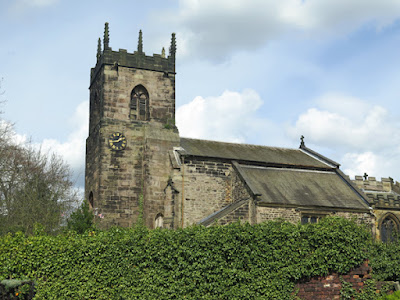 |
| Specimens of red Carboniferous sandstone from Hooton Roberts |
In February 2016, my investigation of the mediaeval churches of South Yorkshire started at St. Helen's church in Treeton and using the X54 bus, I then visited the churches in Aston, Todwick and Harthill – all of which are built in the variety of the Mexborough Rock that is known locally as Rotherham Red sandstone.
I discovered that the red colouration of this sandstone, as seen in these churches and other historic buildings and old boundary walls in the southern part of Rotherham, can be quite variable and shades of dull red/salmon pink to light brown/yellow are common further to the south.
Soon after my exploration of these churches, I visited the Church of St. John the Baptist in Hooton Roberts, which I had passed many times on the X78 bus between Rotherham and Doncaster and, when exploring this small village, I found a few small outcrops of reddened sandstone that I thought were Rotherham Red sandstone.
I consulted my Institute of Geological Sciences map (1975 reprint) and I was surprised to discover that the underlying rock was marked, as I interpret it, the Hooton Roberts Rock and the accompanying geological memoir (1947) mentions that "Near Hooton Roberts the rock, here thickly bedded, is stained red and carries pellets of clayey haematite", although there is no grid reference to pinpoint this.
Furthermore, when passing Thrybergh Reservoir on the X78 bus, the very reddened soil on the south side of the road, which I had seen many times from the upper deck and had always assumed to be derived from the Rotherham Red sandstone, was actually the result of weathering of the underlying Wickersley Rock.
Having since explored Wickersley, Brampton-en-le-Morthen, Morthen, Firsby and Ravenfield, to photograph their listed buildings, and had a good walk across extensive areas of reddened soil, underlain by the Wickersley Rock and Ravenfield Rock, where I had found reddened sandstone, I wanted to have another look at the outcrops in Hooton Roberts – starting at Crooked Lane.
On Holmes Lane, I had previously noted that the dip of the sandstone seemed to be in the opposite direction to the regional dip of the strata affected by the Don Monocline, which can clearly be seen in the topography around Old Denaby. With no measurements of the dip of the strata recorded on this part of the geological map, I contacted the British Geological Survey (BGS) in 2016 to raise a query about this, but my observations were dismissed out of hand.
The outcrops on either side of Holmes Lane had become quite overgrown, but I was able to find a place to discreetly obtain a sample of sandstone with my Estwing hammer, which was different in colour to the samples obtained from Crooked Lane. In 2016, I met the owner of No.17 Doncaster Road, which is built on one of these outcrops, who told me that excavations in her basement had revealed a very dark red sandstone.
After taking another look at the walls of Nos. 15,17 and 19 Doncaster Road and the houses on Holmes Lane, where the oldest parts of these buildings are built in oxblood red sandstone that I have always thought are Rotherham Red sandstone, I still have doubts about the accuracy of the BGS map.
The sandstones here are now mapped as unnamed sandstones belonging to the Pennine Upper Coal Measures Formation (PUCMF), whereas they were before considered to be part of the Pennine Middle Coal Measures Formation (PMCMF).
The geological memoirs for both the Barnsley and Sheffield districts refer to sporadic red staining of PUCMF sandstones, particularly those that occur unconformably beneath the Permian Cadeby Formation and at Ravenfield Park, but I have yet to encounter any quarry or rock exposure in the PUCMF where bright red sandstone is exposed.
The only specimen of red PUCMF sandstone that I have collected to date, from the field to the south of Wickersley Woods, is much brighter than the dull red sandstones collected from Crooked Lane, as viewed when both dry and wet, with the latter being finer grained and lacking the sparkle of the former when viewed in bright sunshine.












No comments:
Post a Comment